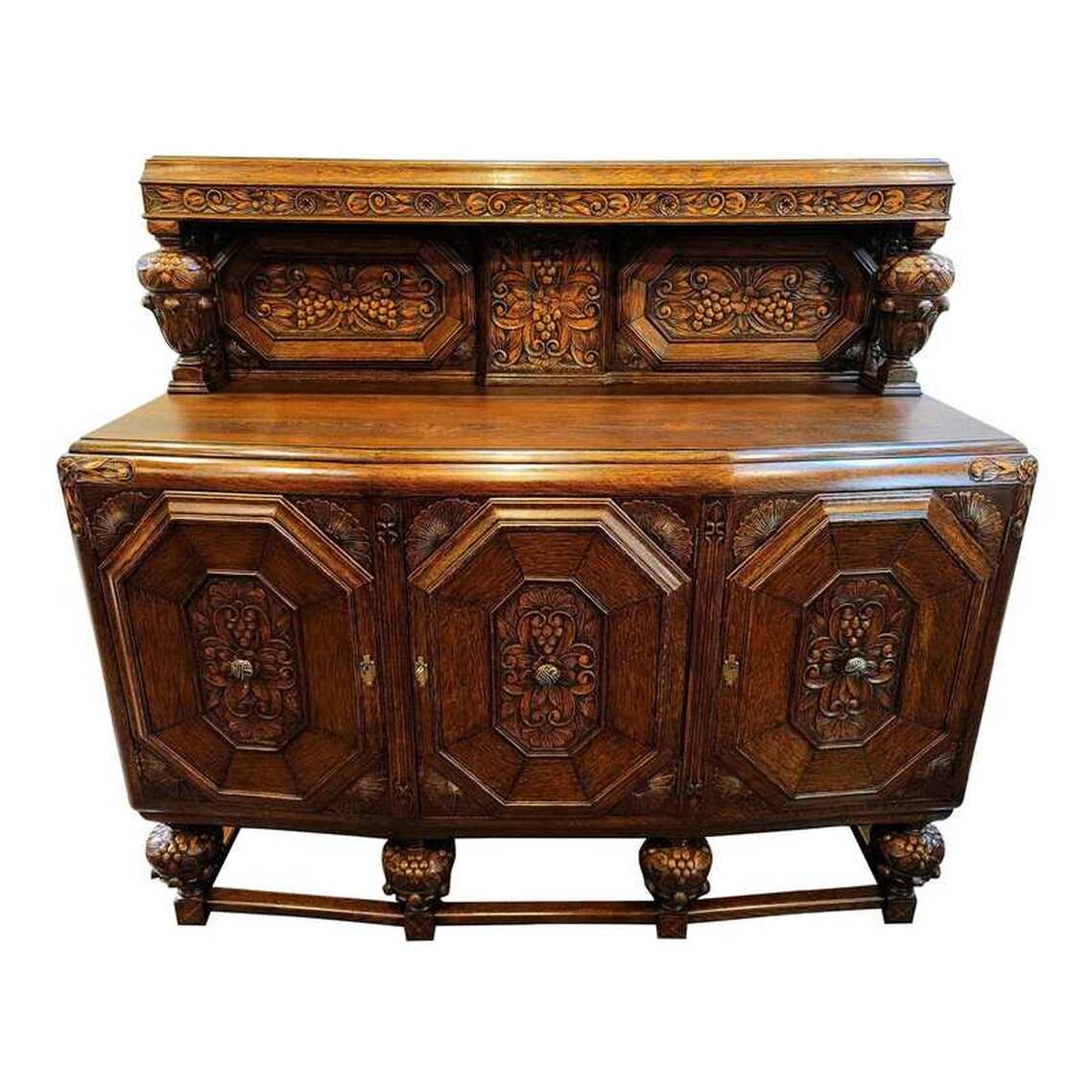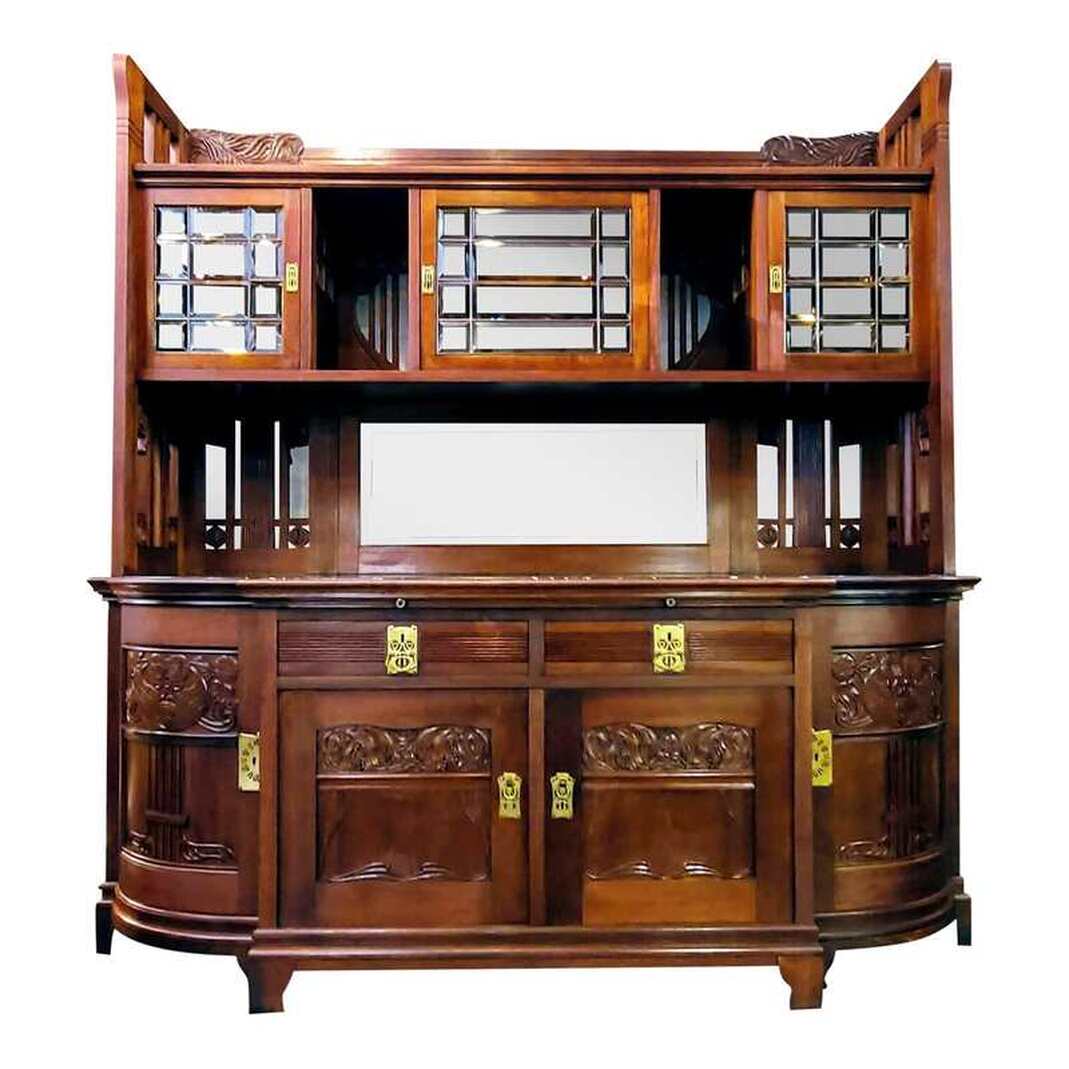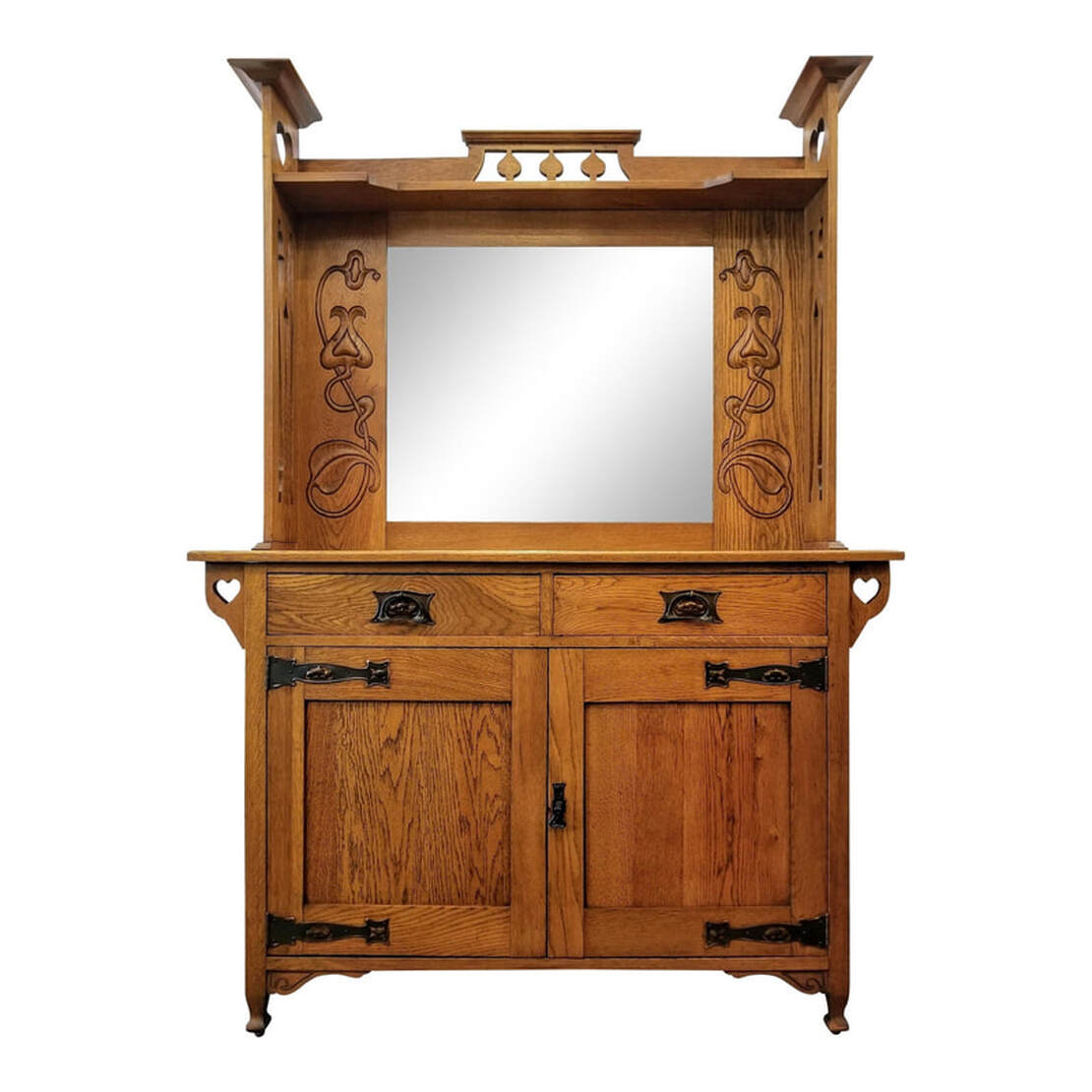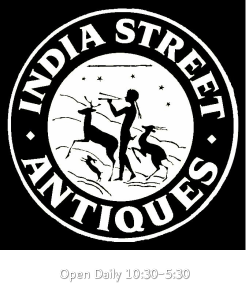Sideboards, Buffets, Servers
Click on the images to access more information about the items.

Elizabethan Style Court Cupboard | England | 1920s
Post-1921 oak sideboard in an English Elizabethan court cupboard form. Court cupboard sideboards were popular in England in the 1920s and 1930s for displaying silver and pewter.
The sideboard is very well constructed of solid oak wood.
The top piece is removable for transport. The backboard features a flat top shelf with molded edge and a relief carved frieze of flowers, leaves, and scrolls. The back is enhanced with panels of relief carved flowers, leaves, scrolls, and grapes in octagonal framing. The stiles are enhanced with relief carved Art Nouveau flower buds with leaves. The cup-and-cover supports show relief carved acanthus leaves on the cup and grapes and leaves on the cover.
The carcass has a center projecting geometric top with a softly molded edge.
The top corners feature relief carved flowers and leaves.
The front is fitted with three cabinet doors enhanced with octagonal framed panels of relief carved flowers, leaves, scrolls, and grapes. At the corners are relief carved anthemion. At the center of each door is a chased brass roundel pull featuring a ribbon "x" and convex dots. The keyhole escutcheons are brass Art Deco vertical geometrics. The stiles in between the doors feature relief carved Art Nouveau flower buds and leaves.
The left cabinet is fitted with one removable shelf.
The center cabinet is fitted with four drawers with Art Deco chrome pulls. The drawers are well-built with mortise and tenon and dovetail construction both front and back. The top drawer is fitted for three sections for storage and lined with green baize.
The right cabinet is fitted with one removable shelf and a slide-out cellarette for four bottles or decanters. The cellarette is removable. The rounds measure 3.5" in diameter and the square measures 3" x 3". The bottom of the cellarette is lined with soft grey colored baize.
The base is constructed with four carved cup-and-cover supports, matching the backboard supports at top, atop diamond fronted block feet; eight stretchers; and plain block feet at the rear.
The sides are plain oak panels.
The top piece is backed with a plain oak wood panel. The carcass is backed with framed beveled panels.
The locks work and five keys are provided.
The brass locks are stamped "TW&S" for Thomas Wilkinson & Son, a key maker existing in England in 1921. In 1936 the business was run by Mrs. S. Wilkinson, and Harold Wilkinson ran the business into the 1970s.
60ʺW × 23ʺD × 54.5ʺH
$ 4995
Click on the image above to learn more and to view further photos.
SOLD

August Ungethüm Buffetschrank | 1905 | Wien
August Ungethüm Kunst Mobelfabrik, Wien, buffetschrank ( buffet cabinet ) from 1905 is among the finest examples of Vienna Secession movement furniture.
A version of this sideboard model from the collection of the Austrian Museum of Applied Arts is featured in the Art Nouveau furniture book, "Möbel des Jugendstils: Sammlung des Österreichischen Museums für Angewandte Kunst" by Vera J. Behal. The description in the book attributes this design to the architect August Ungethüm, Junior, based on comparisons with some published furniture designs by him as the company's co-owner.
The August Ungethüm buffet was produced during the 1902 to 1906 period when the company was manufacturing dinner suites comprising the main sideboard, a smaller sideboard, a long-case clock, a dining table, and six chairs.
The two-piece box structure features oak wood interiors and a brown mahogany wood exterior.
The top of the back wall is curved and features flat-carved Art Nouveau style peacock feathers at each end that curve gracefully over a display shelf.
Across the top are three glazed door storage cabinets housing one shelf apiece. The doors feature square and rectangular faceted colorless glass panes in brass lattice. Each door front is embellished with a pierced brass keyhole escutcheon.
In between the cabinets are two recessed areas illuminated by light coming in through square faceted colorless glass panes inset into the side panels of the cabinets. The back walls of the recesses are decorated with flat-carved fruit and leaf motifs over open slat lyre or harp shapes.
The shaped side supports feature open slats surmounting four square faceted colorless glass panes under which are more open slats, the central slat being fluted, carved leaf and berry motifs at upper corners, and carved berry ornament roundels at lower corners. The same decoration is repeated at each end of the mirror on the back wall.
Below the upper cabinets is an open shelf with an inset shaped Grand Antique black and white marble top.
The back wall behind the open shelf is fitted with a rectangular beveled mirror in a molded frame.
Under the slightly protruding top is an oak pull-out plate fronted with two round brass knobs.
At the top of the buffet base are two side-by-side frieze drawers with horizontally fluted mahogany wood fronts. The drawer interiors are dove-tail constructed of oak wood. The drawers feature inset brass locks and are fronted with brass keyhole escutcheons pierced with stylized Glasgow rose motifs.
Attached to these backplates are shaped brass bail pulls.
Below the drawers is a double-doored cabinet containing one removable shelf. The front panels feature Art Nouveau flowing foliate carvings and are set into the door frames from the back. Pierced brass backplates with attached open drop pulls embellish the front.
On the ends are curved single-door cabinets, each fitted with one shaped and removable shelf. The door panels are set into the door frames from the back and feature flat-carved stylized pinecones, tulips, and flowers upon a fluted column footed tazza. The fronts are embellished with pierced brass keyhole escutcheons featuring an Arts & Crafts stylized Glasgow rose motif.
The side panels are framed plain brown mahogany wood.
The back is constructed of framed beveled oak panels.
The base rests on simplified mahogany wood ogee feet.
85" wide x 30" deep x 87" high
Buffet breaks down into three pieces for transport - the top, the base, and the marble top.
21,995
Click on the photo above to view further photos and to learn about August Ungethüm Kunst Mobelfabrik, the influence of Koloman Moser and Charles Rennie Mackintosh on the design elements of this piece, and Grand Antique marble.

Main Sideboard 2130 | Arts & Crafts | Shapland & Petter of Barnstaple | England | 1894-1903
Shapland & Petter main sideboard 2130 in fumed West Indies mahogany consists of a buffet carcase with cellarette and a mirrored over-mantle with glazed cupboards.
The design of this sideboard dates from about 1894 through 1903. During this period, William Cowie was head of the design team which included James Henry Rudd and Henry Percy Shapland, grandson of the company founder.
The right cabinet contains a unique round slide-out rotating wooden cellarette with turned supports and circular spaces for six bottles or decanters. This is probably a design element from James Henry Rudd as he features a sideboard with built in wood cellarette in the chapter titled "Construction of a Sideboard" in his 1913 book "Cabinet Making: Principles of Designing, Construction and Laying Out Work".
This sideboard has all the geometric elements that create the three-dimensional presence of a Shapland & Petter piece and avoid the monotony of blank spaces and straight lines: rectangular frames and panels, angled arches, projecting cupboards, squared supports, overhanging cornices, slatted rows, pierced shapes, curves, angles, and shaped brackets.
To learn more and to view further photos, click on the image above.
76ʺW × 24.75ʺD × 75ʺH
SOLD

Main Sideboard | William Cowie Design | Shapland & Petter | Raleigh Cabinet Works | England | c. 1900
Antique main sideboard built with burl figured plain oak.
The top is decorated with peacock tail fret rails above a shaped shelf.
The side supports have William Cowie style heart cutouts at the top and Sheraton style urn fretwork throughout the rest of the supports.
The central beveled mirror is framed on either side with oak panels into which are relief- carved Art Nouveau style bursting seed pods and flowers.
The sideboard surface is above two frieze drawers fronted with single Art Nouveau / Arts & Crafts style copper bail pulls and back plates.
To each side of the frieze are supports featuring the William Cowie syle cut-out hearts.
Below the drawers are two cabinet doors with Arts & Crafts copper strap hinges and a single drop pull. The doors open to reveal a storage cabinet with a single shelf.
The sideboard stands upon four spade feet.
There are two curved apron brackets on the front.
Click on the image above to learn more and to view further photos.
54ʺW × 19.5ʺD × 79.5ʺH
3695
